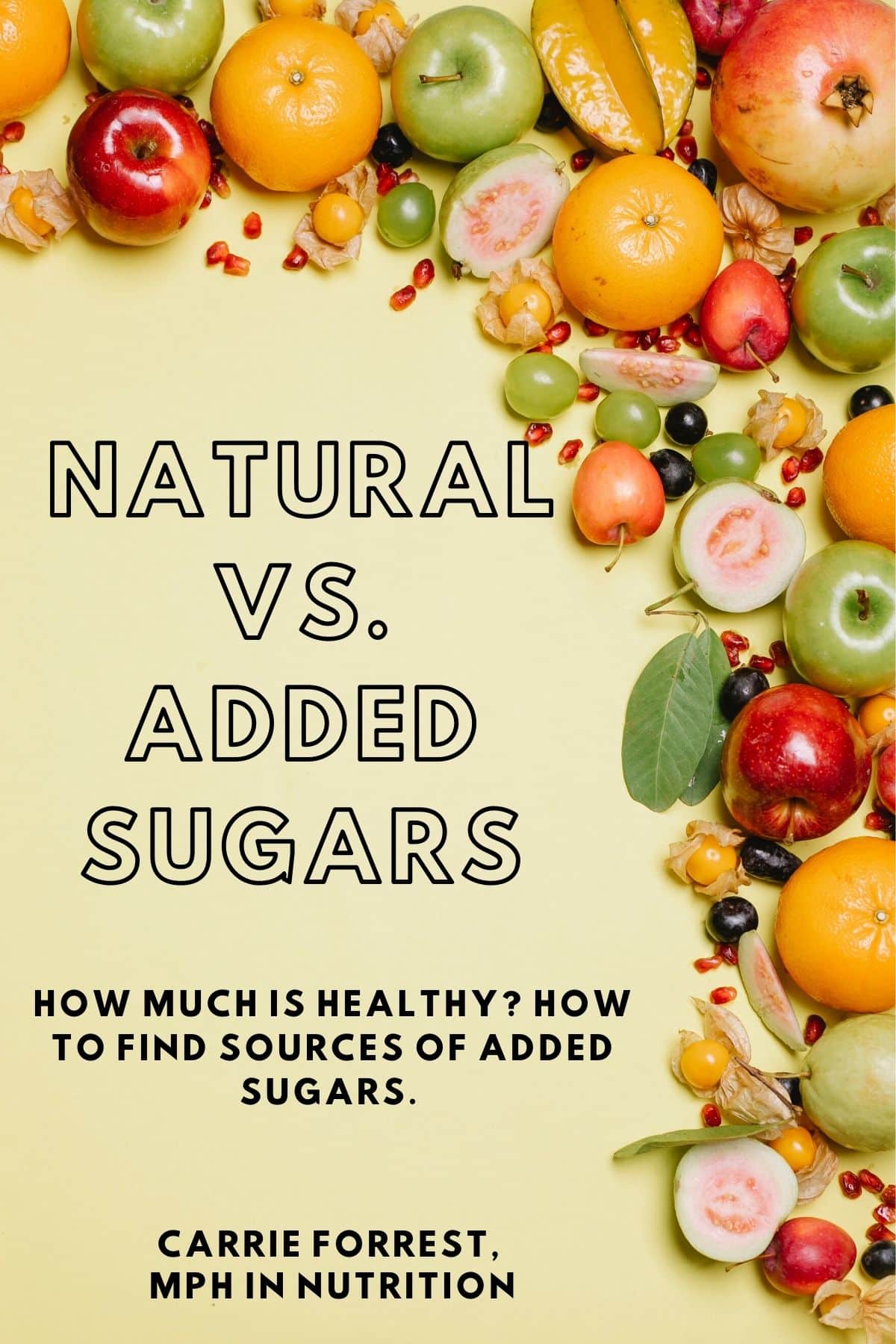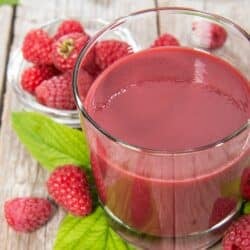Natural Sugars Versus Added Sugars
If you’re trying to cut back on sugar in your diet, you’ll want to learn the difference between natural sugars and added sugars. This article also discusses how to spot sugar on a food label and what you need to know about the health risks or benefits of consuming natural and added sugars.

What Are Natural Sugars?
Natural sugars are those naturally found in whole foods like fruits, vegetables, and dairy products, along with some legumes and grains.
They come in several different forms, including glucose, fructose, or lactose. Some are present as complex carbohydrates, which your body will eventually break down into glucose.
The good thing about natural sugars (also called fruit sugar) is that you consume them intact, along with useful nutrients like vitamins, minerals, protein, and fiber.
Sources of natural sugars also tend to have a high water content and are generally low in calories and sodium.
What are Added Sugars?
The U.S. Department of Agriculture (USDA) defines added sugars as “caloric sweeteners that are added to foods as ingredients during food preparation, at the table, or during food processing”.
So, rather than being naturally present, added sugars are those that are added to foods before you eat them – either added by you or added by food manufacturers as part of the manufacturing process.
The Food Patterns Equivalents Database (FPED) list of added sugars includes:
- cane sugar
- brown sugar
- confectioners’ sugar
- syrups
- honey
- molasses
- dextrose
- fructose
- maltose
- undiluted juice concentrate present in foods and beverages
But this is quite a limited list – there are actually more than 100 names for added sugar that can show up on food labels!
Almost all processed foods contain added sugars. These include foods you might not have considered (like ketchup, salad dressings, barbecue sauce, tomato sauce, pasta sauces, or packaged oatmeal). They also include foods that are marketed as “healthy” (including granola bars, and flavored yogurt).
Many organic foods contain added sugars too.
How Much Sugar is Too Much?
It is worryingly easy to consume far too much sugar. The Dietary Guidelines for Americans 2020–2025 recommends that added sugar should amount to no more than 10 percent of your daily calories.
Meanwhile, the American Heart Association recommends that women should only consume up to 6 teaspoons of added sugar daily and that men should consume no more than 9 teaspoons.
Adding a couple of teaspoons to your coffee in the morning and consuming a bowl of granola can bring you pretty close to that daily limit – and that’s before you have even left the house!
That’s why it’s so important to check the ingredient list of any packaged food you consume.
Differences Between Natural and Added Sugars
1. Natural sugars have nutrients
Whereas natural sugars come as part of a healthy “package” containing other nutrients your body needs, added sugars are devoid of any benefits other than calories.
While your body needs to process added sugars into a form of energy it can use, it doesn’t receive any of the nutrients that it needs to carry out that function.
2. Added sugars may cause sugar crashes
Unlike natural sugars, added sugars tend to lead to “sugar crashes”. These are caused by the rapid drop in your blood glucose levels that you experience immediately after consuming them.
Whereas natural sugars are processed by your body relatively slowly, added sugars are usually used straight away as an energy source.
If they are not used, then they are sent to the liver and stored as fat or glycogen. This is the point at which your glucose levels crash, leaving you feeling irritable and often craving even more sugar.
3. Natural sugars can increase satiety
Another difference is that foods containing only natural sugars leave you feeling full for longer.
For example, milk contains the natural sugar lactose. It also contains protein, which is satisfying. Fruits and vegetables are rich in fiber, which provides bulk and helps keep your appetite at bay.
But because you digest refined sugar so quickly you will often find yourself still feeling hungry after consuming it.
4. Added sugars are linked to health problems
Probably the most significant difference between natural and added sugars is that added sugars are strongly linked with the development of obesity.
Too much added sugar can also lead to heart disease, insulin resistance, inflammation, and other health issues.
Recognizing the value in consuming only natural sugars over added sugars is an important first step in enjoying a healthier diet and minimizing weight gain.
Similarities Between Natural and Added Sugars
Both added sugars and natural sugars are made from a type of carbohydrate and both are broken down in the digestive tract into simple sugars called monosaccharides.
This means that all sugar is the same once it has passed through your stomach and reached your small intestine, whether you got it from a piece of fruit or a sugary soda.
Additionally, both sources of sugar provide 4 calories per gram.
The crucial difference is that added sugars provide you with just 4 calories – and no nutrients. Natural sugars usually deliver nutrients, fiber, and antioxidants, preventing you from trying to fill up on sugar alone.
Sugar FAQs
Is it healthy to eat fruit?
Fruit contains natural sugar, which the body eventually processes into monosaccharides, just as it does with added sugars.
So does that mean that eating fruit is bad? For most people, eating sugar is not bad or unhealthy.
For one thing, it would actually be very difficult to consume too much fructose from fruit alone.
And fruit is such a good source of valuable nutrients – particularly antioxidants and fiber – that it plays an important part in a healthy diet.
Fruit doesn’t need to be fresh to give you these benefits. Frozen and canned fruit is healthy, too, as long as it doesn’t contain added sugars. Check cans carefully to make sure that they say “packed in its own juices”, “unsweetened” or “no added sugar”.
You do, however, need to take a bit more care when it comes to fruit juice and dried fruit.
If you check the packaging, you’ll find that many fruit juices are not actually 100% juice. Instead, they are often made from fruit concentrate mixed with water, to which sugars are added.
But, even pure fruit juices should be consumed with caution. When you eat a piece of fruit, “chewing resistance” slows down how quickly consume it, so you don’t have too much. That doesn’t happen with fruit juice, so it is easy to consume a lot very quickly.
And while juice may retain its vitamins and minerals, it doesn’t have all the fiber of whole fruit.
Subsequently, it doesn’t give you that feeling of being full and it tends to be digested as quickly as added sugar, causing spikes in blood sugar that eventually lead to crashes.
Similarly, the amount of natural sugar in dried fruits is concentrated and very high. Again, it is easy to consume too much too quickly. Be sure to talk with your healthcare provider to help determine if eating fruit is healthy for you.
Can people with diabetes eat fruit?
When managing diabetes, the main considerations are to ensure your weight is under control, your long-term blood glucose is at the correct levels and your blood pressure is stable.
Regularly consuming whole fruit is an important part of meeting these goals. And the recommendation for adults and children to eat 5 servings of fruits and vegetables each day still stands, even for people with diabetes.
Some people worry that the natural sugar in fruit can cause blood glucose levels to go up. Fortunately, though, most fruits are low to medium on the glycemic index. This means that they will have less of an impact on blood glucose levels than other foods containing carbohydrates, such as bread.
The exception would be fruit juice. As mentioned earlier, it’s very easy to consume too much, potentially pushing your blood glucose levels too high. Try to stick to whole fruit and don’t have more than one small glass of fruit juice per day.
And, again, please consult your healthcare provider if you have diabetes or pre-diabetes to see if consuming fruit or fruit juice is safe for you.
What is the glycemic index?
The glycemic index (GI) looks at the impact different carbohydrate-containing foods have on blood sugar levels over a 2 hour period.
It rates foods on a scale from 1 to 100. Foods with a low GI score raise the amount of sugar in the blood at a low rate. High GI foods raise blood sugar levels much more quickly.
Because low GI foods are digested slowly, they will keep you feeling full for longer. High GI foods are less filling and often lead to sugar crashes.
The glycemic index is useful for everyone, but particularly for those with diabetes. Certain fruits – like pineapples, watermelons, and ripe bananas – score highly. While these are still safe for people with diabetes to eat, it’s good to know which fruits should be eaten in moderation.
How do I find added sugars?
There are several ways to spot added sugars.
First, you need to check the nutrition facts label. How many added sugars are listed? Remember that added sugars are different than total sugars which may come from natural sources.
Added sugars can be listed with different names including sugar cane, raw sugar, high fructose corn syrup, or other names.
Next, check the ingredients list and look for any sugars there.
More Helpful Sugar Free Diet Resources
If you’re looking for more support or articles on a sugar-free diet, try these articles:
- Best No Sugar Foods
- How To Do a Sugar Detox
- Tips to Go Sugar-Free
- No Sugar Diet Meal Plan
- Sugar-Free Diet Benefits
And, if you’re looking for support to go sugar-free, consider joining my Sugar Free Challenge!
Don’t Miss These Helpful Articles
Conclusions
Foods with natural sugars are usually low in calories and rich in nutrients. Foods with added sugars tend to be quite the opposite! Try to eliminate added sugars from your diet and replace them with natural sources instead. Not only will this help keep your weight under control, but it will keep your blood glucose levels stable too. Ultimately, you will both look and feel healthier.
Don’t forget to join my newsletter list to get exclusive clean eating recipes and tips. The newsletter is 100% free with no spam; unsubscribe anytime.
About the Author: Carrie Forrest has a master’s degree in public health with a specialty in nutrition and is a certified holistic nutritionist. She is a top wellness and food blogger with over 5 million annual visitors to her site. Carrie has an incredible story of recovery from chronic illness and is passionate about helping other women transform their health. Send her a message through her contact form.
Note: this post is for informational purposes only and is not intended as medical advice. Please consult your healthcare provider for recommendations related to your individual situation.





















Excellent information! Detailed explanation without being overwhelming! THANK YOU!
I’m so glad it was helpful! 🙂